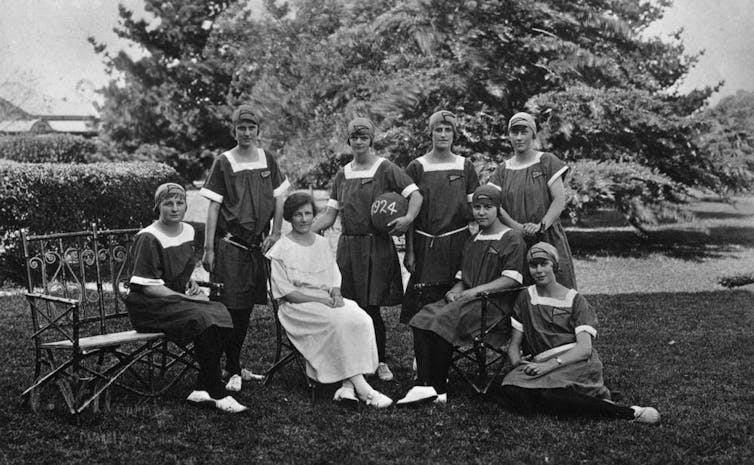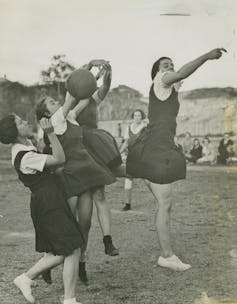Commonwealth Games netball is effectively a proxy world championship.
In the 2018 lineup of 12 competing teams are world champs Australia (the Diamonds), world runners up New Zealand (the Silver Ferns) and the remaining teams that make up the world’s top ten ranked countries.
The Australia – New Zealand rivalry has a long history of close clashes. Incredibly fit, the women are physically strong and up to 188cm (over 6 feet) tall. They put their bodies on the line to win.
But that’s not how netball started. It was designed as a game that allowed women to wear modest clothing, and that did not place undue physical, competitive or moral demands on players.
It’s a bit different now.
Read more:
Can the Commonwealth Games change perceptions of the Gold Coast?
Like basketball, but different
The sport of netball is an English invention that traces its roots to basketball.
In 1891 an American physical educator, James Naismith, created the court and ball game we now know as basketball. It was designed for students linked to the Young Men’s Christian Association, or YMCA.
However, at the time women’s dress conventions of ankle length skirts and wrist length shirts hindered their physical movements, and meant that playing basketball with dribbling, and throwing long passes was difficult.
So some female educators formed a modified version of the game. Instead of changing the female attire to fit the needs of the basketball rules, they modified the game to fit within the accepted feminine practices.

statelibraryqueensland/flickr, CC BY
Women’s basketball, as netball was originally known, emerged as an identifiable sport in the late 1890s when the rules of dribbling were omitted, and the inaugural “rules for women’s basketball” were established. Under these rules the court was divided into three zones, the number of players were increased from five to nine, a smaller ball was used, and there were two umpires, two scorers and two timekeepers.
The modern game of netball still features three zones and two umpires, but has seven players on court.
Netball reaches Australia
Netball – then still known as women’s basketball – was introduced to Australian women in the late 1890s, when games were first played in school around Melbourne.

statelibraryqueensland/flickr, CC BY
The Young Women’s Christian Association (YWCA) – the sister organisation of the YMCA – was instrumental in progressing the game in Australia during the early part of the 20th century. YWCA introduced netball to school children, and also formed women’s competitions in the broader community.
Early Australian versions of the game were played with makeshift equipment including broomsticks, wet paper bags, and washing baskets. The rules were also flexible, and often passed on via word of mouth from those who had prior experience in playing the game.
Netball was initially played indoors but soon included outdoor matches as the number of participants were outgrowing the venues they were originally playing in. Outdoor courts were an important contributor to the game’s early growth since they were easy to construct, and not costly to maintain.
A game for women
Netball was introduced into Australia as a preferred alternative to women’s field hockey. This occurred on the grounds that it was less demanding, had less “rough and tumble”, and was perceived as a less masculine activity for young girls. Netball was viewed as an ideal women’s game since it did not require excessive strength, aggression, or physical exertion.
The belief that netball was not overly competitive and was played with a cooperative and “ladylike” spirit reflected the accepted notion of femininity of the time. Netball was seen as a space for the socialisation of women within specific behavioural boundaries, and as a means through which to develop sound morals, strong leadership and exemplary citizenship. It aimed to instil a set of values that emphasised respectability and polite behaviour.
A 1916 publication on the game stated:
good temper, pluck, determination, extreme agility of mind and body, are traits universally found among Net-Ball players, and best of all perhaps, that inexpressibility happy attitude, esprit de corps.
It was assumed that netball would socialise women into the norms, values, and manners of middle-class culture. These elements made the sport an acceptable past-time hobby for women to engage with, since it did not challenge ideals regarding femininity and competitiveness.
The idea that netball is a women’s game is still evident in the beliefs of many Australians.
No threat to men
From the outset, netball was developed and promulgated without male association or supervision.
The control of teams and competitions remained with women, and men were denied participation as players, coaches and umpires. Women were also selected for all the major management or administration positions. The consensus was that women’s interests would be best served by limiting the game’s administration to women only.
Netball has been highly feminised from its beginnings. With men excluded from the netball scene, some believe this actually advantaged netball’s development. It meant that netball was isolated from male sporting arenas, and did not intrude on the sacred spaces of male-dominated sports such as soccer, cricket, rugby codes and Australian rules football.
Netball did not duplicate male sport practices, and did not threaten men’s sport.
Read more:
The Commonwealth Games are an opportunity to face up to the history of colonialism
The modern game
It was not until 1970 that the game known as women’s basketball in Australia officially became netball.
Although netball is still often stereotyped as a women’s game, the rules and expected behaviours of the game have eased. Societal expectations and ideologies surrounding femininity and sport have been challenged.
The traditional expectation that spectators be quiet, players be polite, and everyone else well-mannered have been loosened, and as a result women can be just as competitive as their male sporting counterparts.
Netball continues to be a popular female participation sport, especially in rural and regional areas of Australia where there are restricted leisure opportunities. Figures from 2016 show that over half a million adult women play netball in Australia each year, along with more than 300,000 girls.
The social team and club environment of netball contribute not just to physical health, but also the psychological and social health of participants and build healthy individuals and communities.
![]() At the Commonwealth Games, netball matches in Pools A (including Australia) and B (including New Zealand) start on April 5, with finals scheduled for April 14 and 15.
At the Commonwealth Games, netball matches in Pools A (including Australia) and B (including New Zealand) start on April 5, with finals scheduled for April 14 and 15.
Rochelle Eime, Associate Professor of Sport Participation, Federation University Australia and Bob Stewart, Visiting Fellow, La Trobe University
This article was originally published on The Conversation. Read the original article.
























